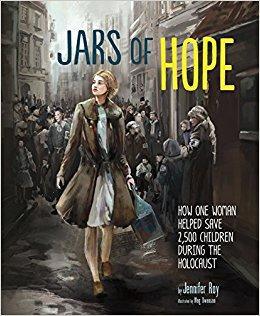
Jars of Hope
Read Aloud Book: Jars of Hope
Story: Kobi Yamada
Illustration: Mae Besom
ISBN-13: 978-1491465530
C3 Framework Key term: Choice: A decision made between two or more possibilities or alternatives.
Synopsis
Irena learned from her father that money, religion, and race do not determine whether people are good or bad. During World War II, she applied this moral principle and saved the lives of 2,500 children from death. This book tells the story of the creative and brave ways in which Irena and her friends saved the children from death, made sure they were protected and cared for and worked to connect them with their families after the war. Note: Additional information about Irena Sendler is available at the World Holocaust Remembrance Center, Yad Vashem’s website.
Discussion
Contextualize: Warsaw is capital of Poland. Before World War II, more than 350,000 Jewish people lived in the city. In 1939, Germany invaded Poland. The following year, the German authorities ordered all Jews to move to a designated residential area, which they sealed off from the rest of the city. A 10-feet high brick wall topped with barbed wire and armed guards ensured seclusion of the ghetto. Warsaw ghetto was crowded, with seven people per room and almost no food, medical supplies, or heating. Within less than two years, 83,000 Jews died of starvation and disease. In 1942, the Germans started mass deportation of Jews from the Ghettos to death camps. The deportation of Jews led to the establishment of The Council for Aid to Jews (Zegota). Irena Sendler, 29-year-old social worker, employed by the Welfare Department of the Warsaw municipality joined Zegota. She sneaked the children out between 1942 and 1943. She built on her contacts with orphanages and institutes for abandoned children to find safe hiding places. Irena helped children reconnect with their families after the war, although in many cases, they could not find surviving family members.
Ethics Connection
Say: Acts of public disobedience against immoral authority were important during World War II. We will explore the uprising in the Warsaw ghetto as a case study. In January 1942, when only 55,000 Jews remained in the ghetto, they organized to resist the next deportation. They did not report as ordered. Instead, Jewish fighters conducted surprise attacks on German troops and escaped through rooftops. The resistance lasted until April when on the first day of Passover, German tanks and artillery troops attacked the ghetto. The fighting lasted three days. After unsuccessful attempts to take over the ghetto, the Germans burned down the entire ghetto. The revolt diverted several troops of Nazis resources from the battlefields, aiding the Nazi defeat. The revolt also promoted a sense of dignity that replaced the shame of obedience. It provided moral courage to others who resisted the Nazi soldiers. On the board, write: “When the Will Defies Fear.” (Taken from a quote by Robert G. Ingersoll). Say: In groups, create a cause-and-effect diagram that demonstrates how acts of moral courage inspired others in World War II. Consider this quote from the last letter from Warsaw Ghetto revolt commander Mordechai Anielewicz: “With the aid of our transmitter we heard the marvelous report on our fighting by the "Shavit" radio station. The fact that we are remembered beyond the ghetto walls encourages us in our struggle.”